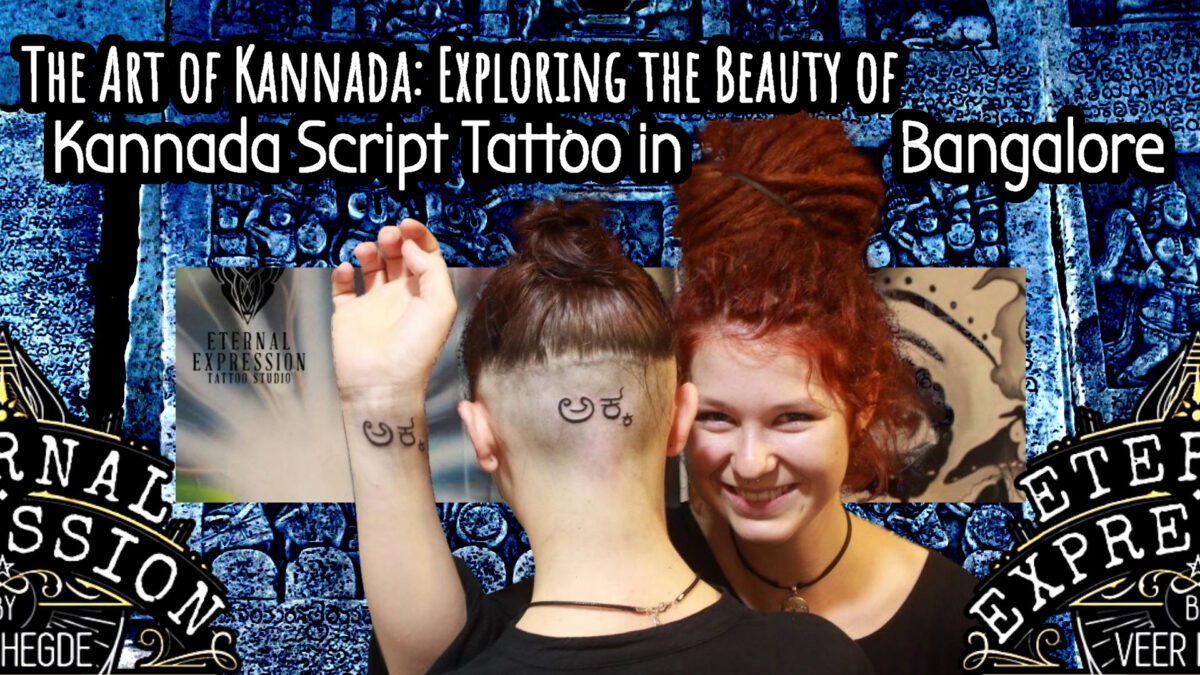
Kannada, one of the Oldest living languages in the world, boasts a rich history that spans thousands of years. Its development and evolution are closely tied to the culture, literature, and people of the southern Indian state of Karnataka. Among the multitude of tattoo styles and scripts available, Kannada tattoos have gained prominence for their unique aesthetic and deep cultural roots. Let’s delve into the fascinating history of Kannada:
Tattoos have been a means of self-expression for centuries, with individuals using their bodies as canvases to convey their beliefs, values, and personal stories.
Kannada’s history is a testament to the enduring strength and cultural richness of this ancient language. With a heritage that spans over two millennia, Kannada continues to thrive and play a vital role in the culture and identity of Karnataka, and its significance in the linguistic landscape of India is undeniable.
Kannada, the script and language of the Indian state of Karnataka, is a rich and intricate script that has captivated tattoo enthusiasts worldwide. The flowing lines and curves of Kannada characters lend themselves beautifully to the art of tattooing, offering a graceful and artistic appearance on the skin.
Kannada script tattoos can take various forms, including single words, phrases, verses, or names. The choice of script, font, and design is highly personal and often reflects the individual’s sentiments, beliefs, or experiences. Tattoo artists skilled in Kannada script pay meticulous attention to detail, ensuring that the characters are beautifully rendered on the skin.
The script used by Kadambas (5th century AD), the first dynastic rule of Karnataka is recognized as Kadamba script and can be seen in the scripts of 5th century AD. Buhler, the famous epigraphist says that the Kadamba script is the earliest form of the present day Kannada script.
https://en.wikipedia.org/wiki/Halmidi_inscription
The script used by the Gangas during 4th AD to 6th AD has been classified as Adi Ganga script. It almost resembles Kadamba Script.
The script used by the Badami Chalukya is called Badami Chalukya script. It can be seen in the records of 6-7 century AD.
The script used by the Rastrakuta rulers is called Rastrakuta script. It can be seen in the records of 8-10 century AD.
The script used by the Kalyana Chalukya rulers is called Kalyana Chalukya script. It can be seen in the records of 10-12 century AD.
One of the most decorative form of ancient Kannada script. The Hoysala Kings used the Kalyana chaluyka script in a more decorative and cursive manner. The present day Kannada script almost resembles scripts used in Kalyana Chalukya and Hoysala Script. Soap stones were used during this period which is also one of the reasons of the cursive nature of these scripts.
There are beautiful Hoysala inscription at Akkana Basadi at Shravana Belagola constructed by Aciyakka, wife of minister Chandramouli of Hoysala King Veera Ballala II in 1181 AD.
The Vijayanagara rulers seem to have given less importance to the writing material of their records during their rule between 14-16 centuries as most of the records are written on rough granite. Hence the script is not decorative or uniform.
Beyond their aesthetic appeal, Kannada script tattoos hold deep cultural significance. Karnataka, with its rich heritage and vibrant culture, is home to Kannada, a classical language with a long history. The script itself has evolved over centuries and is considered an integral part of the state’s identity.
For those with a connection to Karnataka or a profound love for the Kannada language, getting a tattoo in Kannada script is a way to celebrate their cultural roots. It’s a testament to their attachment to the state, its traditions, and its vibrant literary and artistic heritage.
Kannada script tattoos are not limited to those with a Karnataka connection. Many individuals, regardless of their background, choose Kannada script tattoos to express their personal values or commemorate significant life events. Whether it’s a motivational word, a beloved phrase, or a name with special meaning, these tattoos serve as lasting reminders of one’s beliefs and experiences.
Sanskrit Shloka tattoos are not limited to the Devanagri Script,Those with a love for Kannada and the Karnataka heritage can get the Sanskrit shlokas Tattoo in Kannada script. Whether it’s a motivational word, a verse from the Geeta, or a quote with a special meaning, these tattoos can capture the rich history of the Vedic culture of India.
Veer Hegde voted one of India’s Top Tattoo artists in Bangalore is one such Master Calligraphy Tattoo Artist who specialises in Kannada Free hand Tattoos and Custom Kannada Calligraphy besides developing Kannada Ambigrams. Creating a Kannada script tattoo requires a skilled and experienced tattoo artist like Veer who is proficient in the script’s intricacies. The tattoo artist should be able to provide guidance on font styles, placement, and design to ensure the final tattoo is a true work of art.
Kannada script tattoos offer a unique and elegant form of self-expression, blending artistic beauty with cultural significance. Whether you have a deep connection to Karnataka or simply appreciate the graceful aesthetics of Kannada script, these tattoos allow individuals to carry meaningful words and sentiments with them wherever they go. As the world of body art continues to evolve, Kannada script tattoos remain a timeless and cherished choice for those seeking to etch their stories on their skin.